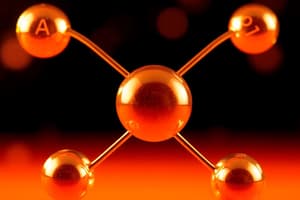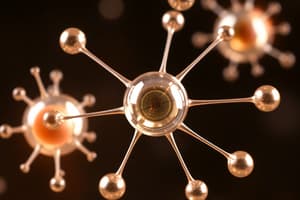Podcast
Questions and Answers
What is the combining power of an element known as?
What is the combining power of an element known as?
- Atomic size
- Valency (correct)
- Reactivity
- Electronegativity
What determines the chemical properties of an element?
What determines the chemical properties of an element?
- Valency electrons (correct)
- Atomic size
- Bonding electrons
- Electronegativity
What type of electrons are not involved in bonding?
What type of electrons are not involved in bonding?
- Bonding electrons
- Lone pair electrons (correct)
- Valency electrons
- Outermost electrons
What is the valency of Hydrogen (H)?
What is the valency of Hydrogen (H)?
What affects the valency of an element?
What affects the valency of an element?
What is the outermost shell of an atom also known as?
What is the outermost shell of an atom also known as?
Flashcards are hidden until you start studying
Study Notes
Valency and Valency Electrons
Definition of Valency
- Valency is the combining power of an element, which is the number of electrons an atom of an element can gain, lose, or share to form bonds with other atoms.
Valency Electrons
- Valency electrons are the outermost electrons of an atom, also known as the valence shell electrons.
- These electrons are involved in chemical bonding and determine the valency of an element.
Importance of Valency Electrons
- Valency electrons determine the chemical properties of an element, such as its reactivity and ability to form bonds with other atoms.
- The number of valency electrons determines the valency of an element.
Types of Valency Electrons
- Lone pair electrons: electrons that are not involved in bonding, but are present in the valence shell.
- Bonding electrons: electrons involved in forming bonds with other atoms.
Factors Affecting Valency
- Atomic size: smaller atoms tend to have a higher valency due to their smaller size.
- Electronegativity: elements with high electronegativity tend to have a higher valency.
Examples of Valency
- Hydrogen (H) has a valency of 1, as it can form one bond with another atom.
- Oxygen (O) has a valency of 2, as it can form two bonds with other atoms.
- Carbon (C) has a valency of 4, as it can form four bonds with other atoms.
Note: These notes provide a concise overview of valency and valency electrons. For more detailed information, it's recommended to consult a comprehensive chemistry textbook or online resources.
Studying That Suits You
Use AI to generate personalized quizzes and flashcards to suit your learning preferences.




